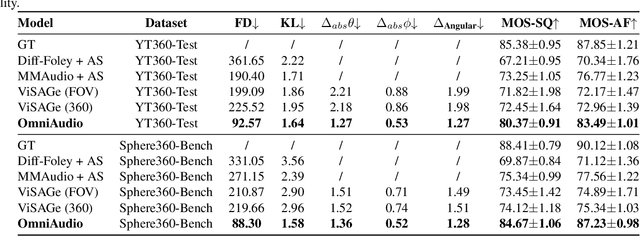Kaicheng Luo
ThinkSound: Chain-of-Thought Reasoning in Multimodal Large Language Models for Audio Generation and Editing
Jun 26, 2025



Abstract:While end-to-end video-to-audio generation has greatly improved, producing high-fidelity audio that authentically captures the nuances of visual content remains challenging. Like professionals in the creative industries, such generation requires sophisticated reasoning about items such as visual dynamics, acoustic environments, and temporal relationships. We present \textbf{ThinkSound}, a novel framework that leverages Chain-of-Thought (CoT) reasoning to enable stepwise, interactive audio generation and editing for videos. Our approach decomposes the process into three complementary stages: foundational foley generation that creates semantically coherent soundscapes, interactive object-centric refinement through precise user interactions, and targeted editing guided by natural language instructions. At each stage, a multimodal large language model generates contextually aligned CoT reasoning that guides a unified audio foundation model. Furthermore, we introduce \textbf{AudioCoT}, a comprehensive dataset with structured reasoning annotations that establishes connections between visual content, textual descriptions, and sound synthesis. Experiments demonstrate that ThinkSound achieves state-of-the-art performance in video-to-audio generation across both audio metrics and CoT metrics and excels in out-of-distribution Movie Gen Audio benchmark. The demo page is available at https://ThinkSound-Demo.github.io.
OmniAudio: Generating Spatial Audio from 360-Degree Video
Apr 21, 2025



Abstract:Traditional video-to-audio generation techniques primarily focus on field-of-view (FoV) video and non-spatial audio, often missing the spatial cues necessary for accurately representing sound sources in 3D environments. To address this limitation, we introduce a novel task, 360V2SA, to generate spatial audio from 360-degree videos, specifically producing First-order Ambisonics (FOA) audio - a standard format for representing 3D spatial audio that captures sound directionality and enables realistic 3D audio reproduction. We first create Sphere360, a novel dataset tailored for this task that is curated from real-world data. We also design an efficient semi-automated pipeline for collecting and cleaning paired video-audio data. To generate spatial audio from 360-degree video, we propose a novel framework OmniAudio, which leverages self-supervised pre-training using both spatial audio data (in FOA format) and large-scale non-spatial data. Furthermore, OmniAudio features a dual-branch framework that utilizes both panoramic and FoV video inputs to capture comprehensive local and global information from 360-degree videos. Experimental results demonstrate that OmniAudio achieves state-of-the-art performance across both objective and subjective metrics on Sphere360. Code and datasets will be released at https://github.com/liuhuadai/OmniAudio. The demo page is available at https://OmniAudio-360V2SA.github.io.
 Add to Chrome
Add to Chrome Add to Firefox
Add to Firefox Add to Edge
Add to Edge